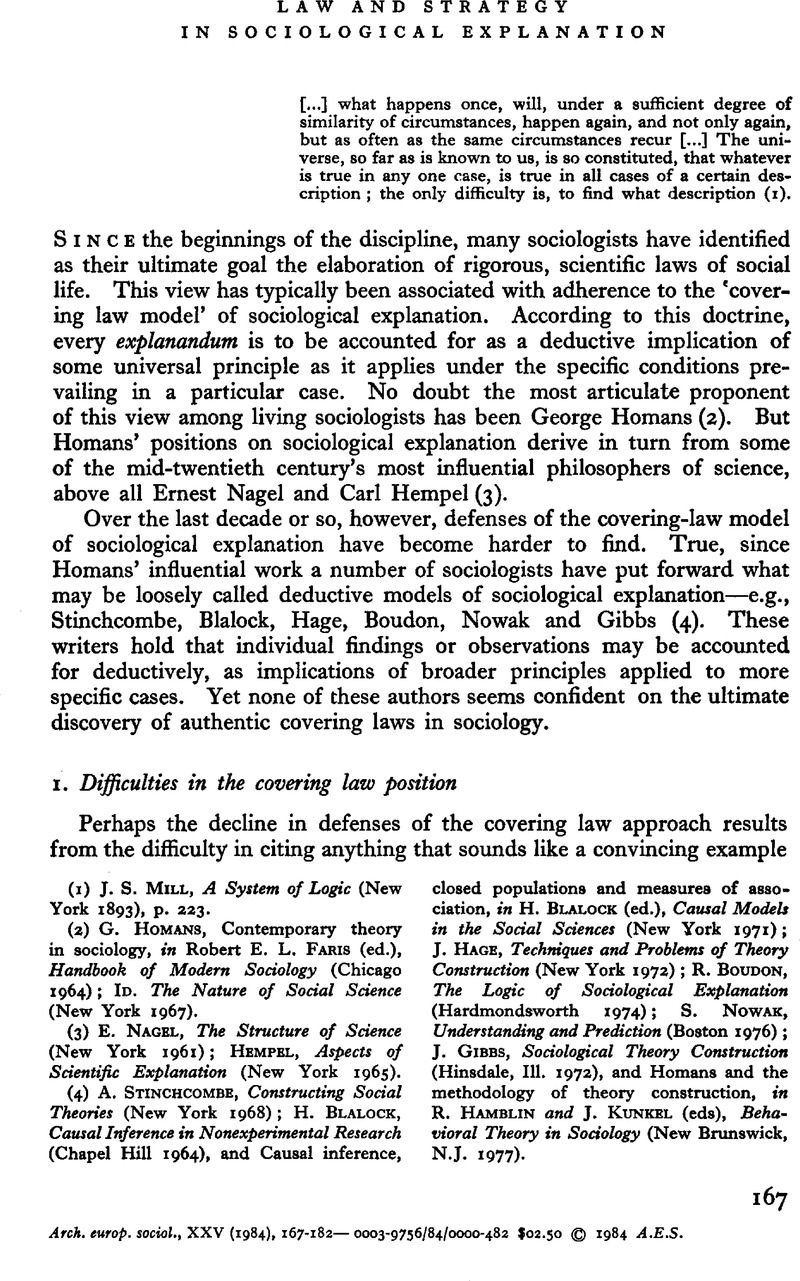No CrossRef data available.
Published online by Cambridge University Press: 28 July 2009

(1) Mill, J. S., A System of Logic (New York 1893), p. 223Google Scholar.
(2) Homans, G., Contemporary theory in sociology, in Faris, Robert E. L. (ed.), Handbook of Modern Sociology (Chicago 1964)Google Scholar; Id.The Nature of Social Science (New York 1967).
(3) Nagel, E., The Structure of Science (New York 1961)Google Scholar; Hempel, , Aspects of Scientific Explanation (New York 1965)Google Scholar.
(4) Stinchcombe, A., Constructing Social Theories (New York 1968)Google Scholar; Blalock, H., Causal Inference in Nonexperimental Research (Chapel Hill 1964)Google Scholar, and Causal inference, closed populations and measures of association, in Blalock, H. (ed.), Causal Models in the Social Sciences (New York 1971)Google Scholar; Hage, J., Techniques and Problems of Theory Construction (New York 1972)Google Scholar; Boudon, R., The Logic of Sociological Explanation (Hardmondsworth 1974)Google Scholar; Nowak, S., Understanding and Prediction (Boston 1976)CrossRefGoogle Scholar; Gibbs, J., Sociological Theory Construction (Hinsdale, Ill. 1972)Google Scholar, and Homans and the methodology of theory construction, in Hamblin, R. and Kunkel, J. (eds), Behavioral Theory in Sociology (New Brunswick, N.J. 1977)Google Scholar.
(5) Homans, , The Nature of Social Science, p. 44Google Scholar.
(6) Hempel, , op. cit., pp. 424, 236–237Google Scholar.
(7) Ibid., pp. 267–268; MacIntyre, A., Is a science of comparative politics possible?, in Ryan, Alan (ed.), The Philosophy of Social Explanation (Oxford 1973), p. 175Google Scholar.
(8) Davidson, D., Essays on Actions and Events (Oxford 1980), p. 224Google Scholar.
(9) Dray, W., Laws and Explanation in History (London 1957)Google Scholar; Scriven, M., A possible distinction between traditional scientific disciplines and the study of human behavior, in Minnesota Studies in the Philosophy of Science, Vol. I edited by Feigl, Herbert and Scriven, Michael (Minneapolis 1956)Google Scholar, and Explanations, predictions and laws, in Minnesota Studies in the Philosophy of Science, Vol. III edited by Feigl, Herbert and Maxwell, Grover (Minneapolis 1962)Google Scholar; Lukes, S., Methodological individualism reconsidered, British Journal of Sociology, XIX (1968), 119–129CrossRefGoogle Scholar; MacIntyre, op. cit.; Garfinkel, A., Forms of Explanation (New Haven 1981)Google Scholar.
(10) MacIver, R., Social Causation (New York 1942)Google Scholar.
(11) Ibid. p. 63.
(12) Ibid. p. 251.
(13) Garfinkel, , op. cit. p. 143Google Scholar.
(14) Dretske, F., Contrastive statements, Philosophical Review, LXXXI (1972), 411–437CrossRefGoogle Scholar.
(15) Ibid. 411–412.
(16) Gorovitz, S., Causal judgment and causal explanation, Journal of Philosophy, LXII (1965), 695–711CrossRefGoogle Scholar.
(17) Garfinkel, op. cit.
(18) Ibid. p. 30.
(19) Garfinkel, op. cit.
(20) Ibid.
(21) Ibid. p. 56.
(22) Ibid. p. 155.
(23) Boudon, R., The Crisis in Sociology (New York 1980), p. 227CrossRefGoogle Scholar.
(24) Ibid. p. 254.
(25) Ibid. p. 228.
(26) Myrdal, G., Value in Social Theory (London 1958)Google Scholar; Streeten, P., Introduction in Myrdal, , op. cit., p. xivGoogle Scholar; see also Rule, J.Insight and Social Betterment (New York 1978)Google Scholar, Chapter VI.
(27) National Advisory Commission on Civil Disorders, Report (Washington, D.C. 1968), p. 5Google Scholar.
(28) Wilson, J. Q., Social science and public policy: a personal note, in Lynn, Jr (ed.), Knowledge and Policy: The Uncertain Connection (Washington, D.C. 1978)Google Scholar.
(29) American Sociological Review, XXXV (1970). 627–649Google Scholar.
(30) Ibid. p. 643.
(31) Ibid. pp. 643–644.
(32) Gurr, T., A causal model of civil strife: a comparative analysis of new indices, in Feierabend, I. and Feierabend, R. (eds), Anger, Violence and Politics (Englewood, N.J. 1972)Google Scholar.
* The author wishes to thank Lewis Coser, Dagfinn Føllesdal, Mark Granovetter, George Homans, Michael Simon, John Sumser, Kurt Wolff and others for commentary useful in the preparation of this study; appreciation is also expressed to sociological audiences at McGill University and the State University of New York at Stony Brook for providing forums for early versions of the work.